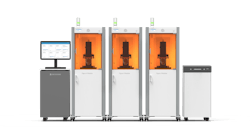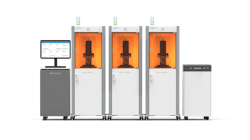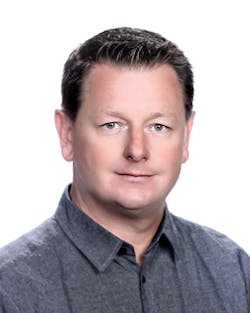Figure 4 printer from 3D Systems offers speed, connectivity
Speed — once a major constraint on 3-D printing’s viability — is a selling point for the newest printer, the Figure 4, from 3D Systems. Its performance is emblematic of a technology that’s making inroads in manufacturing, thanks to its accessibility and falling costs.
“We literally blur the distinction between individual layers, and we are really almost playing a movie during that print process and doing it dynamically,” said Scott Turner, the company’s director of advanced R&D. “We’re processing the polymers really fast, and that allows us to process more material.”
Innovations are overcoming the traditional hurdles to large-volume, 3-D production, such as time and material limitations, he said. And, increasingly, people are realizing the advantages of being able to make parts without having to first make molds.
The Figure 4 system is modular, so additional printers can be added as needed.
“You can have, let’s say, 10 of them controlled by a single computer that drives them all and produces parts in a larger volume of the same quality from the same data that you prototyped with,” he said.
The company also sells fully automated printers.
“This is robotics and monitoring and inspection all integrated into a manufacturing work cell that can operate in a lights-out environment producing the same part that was prototyped on a standalone engine. It’s really a continuum that you can start in with an R&D mode.”
In addition, today’s photopolymers, and other resins used in 3-D printing, have improved to the point that they can meet specifications for nearly any part, he said.
“They can do the work, yes, absolutely,” Turner said, “Now, I would not try to say that photopolymers today have the complete encyclopedia of derivatives that thermoplastics do, but thermoplastics are held back. Thermoplastics require tools. They go through a melt process, and they’re injected under pressure, and the part-design constraints require uniform wall thickness.”
As additive manufacturing technology has improved, the cost of buying 3-D printers has fallen.
“The systems to do additive manufacturing and 3-D printing were very capital-intensive, and some of them still are, but a lot of them aren’t,” Turner said. “When you look at a Figure 4 system, a $20,000 investment in a stand-alone printer that can process these materials really reduces those barriers, and the systems don’t require a lot of floor space and don’t require a lot of other facilities. They don’t require cooling, chilling, water sources or inert gases or things like that.”
A 3-D printer can be rolled onto a manufacturing floor and start making parts.
Injection molders considering the move can start slowly to see if the technology works for them.
Processors can eventually transition from prototyping, for example, to using 3-D printing to launch a new product quickly, without waiting while the injection mold is made. In addition, they might use 3-D printing if “you can’t live with the constraints of injection molding,” Turner said.
Turner said 3-D printing won’t completely replace injection molding, but it is a complementary process..
Bruce Geiselman, senior reporter
3D Systems Inc., Rock Hill, S.C., 803-326-3930, www.3dsystems.comAbout the Author
Bruce Geiselman
Senior Staff Reporter Bruce Geiselman covers extrusion, blow molding, additive manufacturing, automation and end markets including automotive and packaging. He also writes features, including In Other Words and Problem Solved, for Plastics Machinery & Manufacturing, Plastics Recycling and The Journal of Blow Molding. He has extensive experience in daily and magazine journalism.


